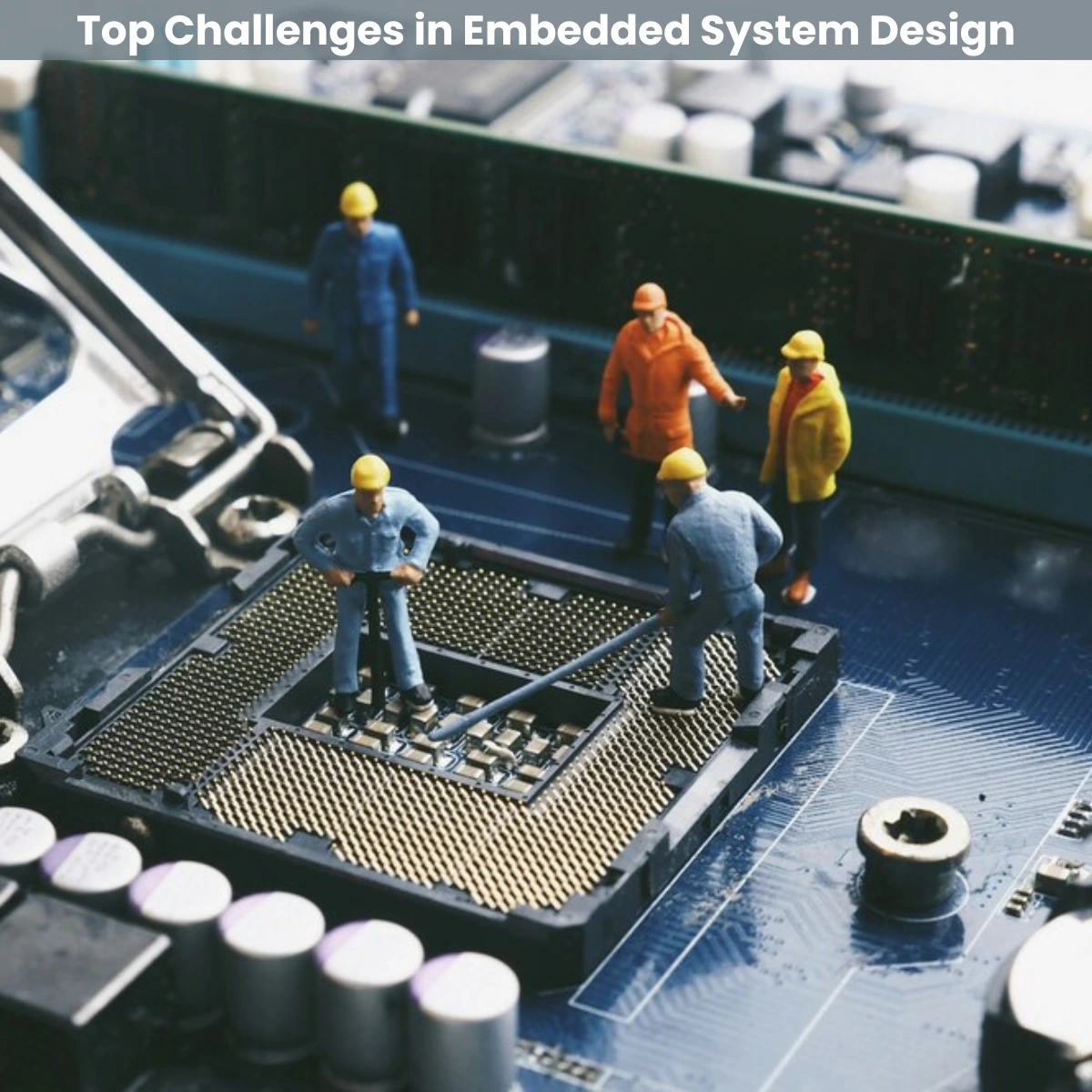
Top Challenges in Embedded System Design
- February 22, 2025
Embedded systems are the backbone of ultramodern technology, powering operations in consumer electronics, artificial robotization, automotive systems, and healthcare devices. still, designing embedded systems is fraught with challenges that bear moxie in hardware- software integration, power operation, real- time performance, security, scalability, and compliance with nonsupervisory standards. As embedded systems come more complex, masterminds must address new issues, including AI/ ML integration, IoT security, and force chain dislocations. In this blog, we explore the top challenges in embedded system design and strategies to overcome them.
1.
Hardware- Software Integration Issues
One
of the most frustrating aspects of embedded system design is ensuring flawless
commerce between hardware and software. remedying why a detector fails to
communicate or why a micro controller (MCU) is unresponsive can take hours. The
primary challenges include
•
Driver Compatibility: Ensuring the software interacts rightly with the hardware
requires dependable driver, which may be delicate to find or develop.
•
Hardware Failures: A defective element can disrupt the entire system,
making troubleshooting time- consuming.
•
Firmware Bugs: Writing effective and bug-free firmware is pivotal, but
remedying real- time surroundings is grueling.
•
Embedded Linux vs. Bare- Metal Programming: Choosing between an embedded
zilches (e.g., Free RTOS, Zephyr) and bare- essence programming affects
performance and debugging complexity.
•
FPGA & SoC Considerations: numerous ultramodern designs involve
Field- Programmable Gate Arrays (FPGAs) or System- on- Chip (SoC)
infrastructures, adding complexity to integration.
Solution
Following
rigorous testing procedures and using debugging tools like JTAG debuggers, Open
OCD, GDB, and oscilloscopes can significantly ameliorate integration.
2.
Power Management Constraints
Power
consumption is a major concern, especially for battery- operated devices like
wearables and IoT bumps. Optimizing power effectiveness is pivotal to
maintaining a long battery life. Challenges include
•
Balancing Performance and Power Efficiency: Advanced processing power
frequently leads to increased energy consumption.
•
Sleep Mode Management: Effective wake- sleep cycles extend battery life
but bear precise programming.
•
Voltage Regulation Issues: Poor voltage regulation can beget insecurity.
•
Power Management ICs (PMICs): Opting the right PMICs helps optimize
energy operation.
Solution
Using
low- power microcontrollers, implementing dynamic power operation, and using
ways like DVFS (Dynamic Voltage and frequence Scaling) can help optimize power
consumption.
3.
Real- Time Performance and Timing Constraints
Numerous
embedded systems operate in real- time surroundings where indeed minor
detainments can affect in system failure. Challenges include
•
Interrupt Handling: Efficiently managing interrupts ensures timely
responses.
•
Latency Issues: Processing detainments can disrupt system functionality.
•
Synchronization Problems: Coordinating multiple tasks without conflicts
is delicate.
•
Time- Sensitive Networking (TSN): Ensuring low- latency communication
between embedded bumps.
Solution
Using
a Real- Time Operating System (RTOS) like Free RTOS, VxWorks, or Zephyr helps
manage timing constraints. expansive testing and profiling tools insure precise
prosecution timing.
4.
Security Vulnerabilities
With
the adding connectivity of embedded systems, security has come a critical
concern. Security challenges include
•
Firmware Exploits: Attackers can manipulate firmware to gain system
control.
•
Data Encryption Issues: Secure data transmission and storehouse are
necessary.
•
Physical Security Risk: If attackers gain physical access to hardware,
they can prize sensitive data.
•
IoT Security Threats: Ensuring secure communication between connected devices.
•
Secure Boot & Trusted Platform Module (TPM): Implementing a secure
charge process prevents unauthorized firmware changes.
Solution
Secure
charge mechanisms, hardware encryption modules, and cybersecurity fabrics (NIST,
IoT security standards) can alleviate pitfalls.
5.
Scalability and Future- Proofing
As
technology advances, embedded systems must be scalable to accommodate unborn
upgrades. crucial scalability challenges include
•
Limited Processing Power: Numerous embedded systems have fixed
capabilities, making expansion grueling.
•
Memory Constraints: Limited memory restricts software updates.
•
Backward Compatibility: Ensuring updates don’t break being
functionalities.
•
Remote Firmware Updates (OTA): Keeping devices up- to- date without
physical access.
Solution
Choosing
hardware with upgrade paths, modular software design, and flexible
communication interfaces helps insure scalability.
6.
Regulatory and Compliance Issues
Embedded
systems must misbehave with colorful assiduity regulations, including
•
Medical Devices: Must meet FDA or IEC 60601 Standards.
•
Automotive Systems: Bear ISO 26262 compliance for functional safety.
•
IoT Security Standards: Compliance with cybersecurity regulations is
obligatory.
•
Electromagnetic hindrance (EMI) Compliance: Ensuring systems don't
intrude with other electronic Devices.
Solution
Following
strict attestation, confirmation, and assiduity stylish practices ensures
nonsupervisory compliance.
7.
Memory Management Challenges
Memory
constraints in embedded systems make effective memory operation critical.
Common issues include
•
Stack Overflows: Improper memory allocation can beget crashes.
•
Heap Fragmentation: Dynamic memory allocation can lead to
inefficiencies.
•
Code Optimization: Writing effective law that consumes minimum memory
while maintaining performance.
Solution
Using
static memory allocation and careful optimization ways improves memory
operation.
8. Debugging and Testing Difficulties
Debugging embedded systems is much harder than remedying traditional software. Challenges include
•
Limited Debugging Tools: Many embedded devices warrant proper debugging
support.
•
Real- World Testing Complexity: Bluffing real- world conditions are
delicate.
•
Hardware Reliance: A software issue may actually be caused by a hardware
fault.
Solution
Using
hardware - in- the- Loop (HIL) testing, parrots, simulators, and nonstop
Integration/ nonstop Deployment (CI/ CD) helps streamline debugging.
9.
Cost Constraints
Cost
optimization is pivotal, especially in consumer electronics. Cost- related
challenges include
•
Choosing Affordable Components: Balancing quality and cost.
•
Production Costs: Scaling embedded devices while maintaining cost
effectiveness.
•
Optimization Trade- Offs: Cutting costs may impact performance.
•
Supply Chain Issues: Semiconductor dearth and fake element pitfalls.
Solution
Careful
element selection, force chain operation, and Design- for- Manufacturing (DFM)
principles can help control costs.
10.
Interfacing with Multiple Communication Protocols
Embedded
systems frequently need to communicate using colorful protocols similar as I2C,
SPI, UART, CAN, and Ethernet. Challenges include
•
Protocol Incompatibility: Ensuring different protocols work together.
•
Latency Issues: Some communication protocols have advanced latency.
•
Bandwidth Limitations: Managing data transmission efficiently.
•
Wireless Connectivity Challenges: Handling Wi- Fi, Bluetooth, LoRa,
Zigbee, and MQTT protocols in embedded operations.
Solution
Using
proper protocol transformers, middleware, and well- defined interfaces improves
communication trust ability.
11.
AI/ ML Integration in Embedded Systems
With
the rise of AI- driven operations, embedded systems decreasingly incorporate
machine literacy. Challenges include
•
Running ML on Edge Devices: Optimizing Tensor Flow Lite and bitsy ML for
low- power devices.
•
Processing Constraints: Limited computational power for AI tasks.
•
Real- Time Decision Making: Ensuring AI models operate within timing
constraints.
Solution
Using
effective AI fabrics and hardware accelerators like Edge TPUs and Neural
Processing Units (NPUs) enhances AI performance in embedded systems.
Conclusion
Embedded system design presents multitudinous challenges, but prostrating them leads to more effective, scalable, and secure products. Whether diving power constraints, remedying real- time issues, or implementing AI, masterminds must stay streamlined with the rearmost trends and technologies. By using stylish practices, advanced tools, and rigorous testing, we can produce robust embedded systems for the future.

SHARE THIS BLOG